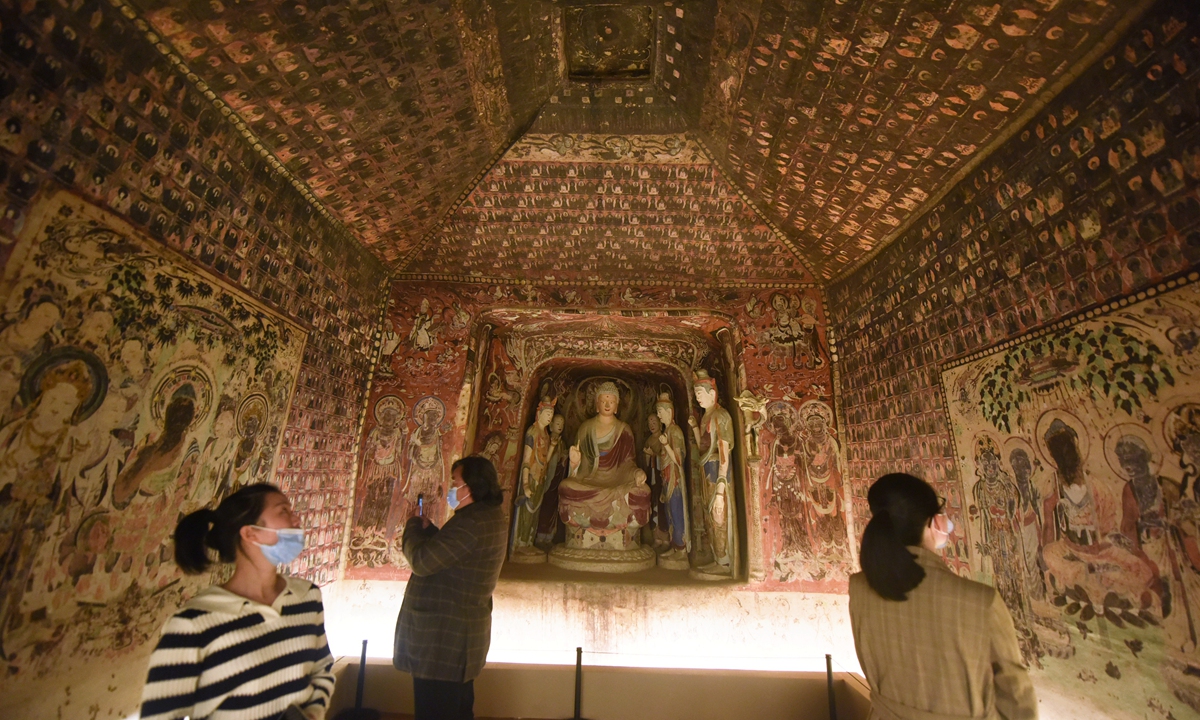ARTS / BOOKS
Compendium of Dunhuang’s ethnic Tibetan manuscripts to be released in 2022

Visitors look at a replica of a cave in the Dunhuang Mogao Grottoes reproduced with 3D digital printing technology at the Zhejiang University Museum of Art and Archaeology in Hangzhou, East China's Zhejiang Province, on November 2, 2021. Photo: VCG
A collection of ancient ethnic Tibetan manuscripts collected in the city of Dunhuang in Northwest China's Gansu Province is set to be published in 2022, the Gansu Ethnic Publishing House announced on Sunday.
The 30-volume compendium, Gansu Dunhuang Tibetan Literature, contains more than 6,700 manuscripts from 14 institutions, including museums, libraries and research institutes in Gansu Province. Most of the content consists of ancient Buddhist texts, Dang Chenfei, head of the publishing house under the Reader Publishing Group, told the Global Times in an interview on Monday.
"The multi-volume book is a milestone in the sorting and preservation of Dunhuang Tibetan manuscripts as it is the first collection to be printed as text instead of photos of the documents. It will promote the further development of Dunhuang ethnic Tibetan manuscript research around the world," Dang said.
In 1900, the Mogao Grottoes in Dunhuang, which had been closed for thousands of years, were opened, and a large number of ancient Chinese manuscripts, prints and works of art were unearthed, which are regarded as major discoveries in the modern archaeological history in the world.
Besides writings in ancient Chinese, documents written in the Tibetan script make up the majority of documents found in the Dunhuang collection, making this new book series a written record of Tibetan literature.
According to Dang, the book contains a lot of valuable historical materials that have not been seen by the public, including documents about the culture and history about the Tubo period (633-842) on the Qinghai-Xizang Plateau, a local authority that existed alongside the Tang Dynasty (618-907).
Dang said that the Reader Publishing Group have worked with the Dunhuang Academy for over 10 years and have published over 400 books about Dunhuang research. Most of the books are about Chinese manuscripts and some are about the Tibetan manuscripts. It also published some books on the ancient Silk Road and Tangutology, the study of the ancient Tangut people.
He added that this publication took about five to six years as the manuscripts are very old and delicate and so are difficult to sort through and organize. Researchers and experts need to repeatedly proofread the ancient documents and research some parts that are missing from the original manuscripts.
Currently, the typesetting for the 30 volumes, which were proofread three times, is underway, with a publication date in December being the goal.
Like the Chinese manuscripts, the Tibetan manuscripts from the Mogao Grottoes were looted by imperialists after they were unearthed.
At present, over 5,000 Tibetan manuscripts from Dunhuang are scattered all over the world, including more than 4,200 in the National Library of France, over 1,400 items in the British Library, and also sporadic collections in Russia, Japan and other places.
However, the collection of the cultural relics from the Tubo period (633-842) and ancient Tibetan documents from the Tubo in China are unique.
In recent years, a publishing house in Shanghai has negotiated with foreign collection units and has successively published the Dunhuang manuscripts in French, English, and Russian, including the Dunhuang Tibetan catalogues in English and French, according to the publishing house.


